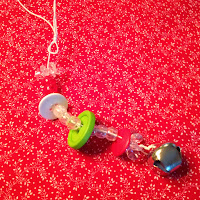This holiday season, let your children experience the joy of giving. You can try to teach them … or you can step back and let them learn!
 You will have enough saved up to go shopping, big or small, for someone who might not have much for the holiday. My little ones always like to pick something for someone their own age, but take your child's lead! Remember to reflect on the giving :)
You will have enough saved up to go shopping, big or small, for someone who might not have much for the holiday. My little ones always like to pick something for someone their own age, but take your child's lead! Remember to reflect on the giving :)
Spark some interest in some of the great organizations that are gathering gifts for the less fortunate. Let your children know that they can help make the holiday special for someone else … elves come in all shapes and sizes! Let them know that they can be "helpers" to spread the Holiday Spirit.
Then, find or work together to make a container that will become a focal point for gathering loose change (and good thoughts!) during the next few weeks. You might take a holiday tin or a special basket or decorate a gift bag … whatever you decide to do will be great!
Next, have your children check around for change in pockets, junk drawers, cars, and the sofa cushions :) It will be amazing how the change adds up! When you go to the store or come home from a day's outings, help your little ones to "find" the change and put it in the container. When you're ready, take that change to the bank or grocery store change counter. If you're not near one of these, or just looking for practice counting coins, you can separate and roll them up yourselves!
 You will have enough saved up to go shopping, big or small, for someone who might not have much for the holiday. My little ones always like to pick something for someone their own age, but take your child's lead! Remember to reflect on the giving :)
You will have enough saved up to go shopping, big or small, for someone who might not have much for the holiday. My little ones always like to pick something for someone their own age, but take your child's lead! Remember to reflect on the giving :)
While you're waiting for the coins to pile up, create some one-of-a-kind sparkling ornaments to share along with your gifts. You'll need some chenille sticks or florist wire, some jingle bells or small buttons or charms, and beads of any and all colors and shapes.
At one end of the wire/pipe cleaner, attach an anchor of some sort - we had some jingle bells, so we used them. Then, let your child create a masterpiece, adding things until its about one-third full. Twist the remainder into a loop for hanging and you have a beautiful ornament/door hanger to give away! (Make another for a great gift for grandparents or someone special!)
Have fun!!
























